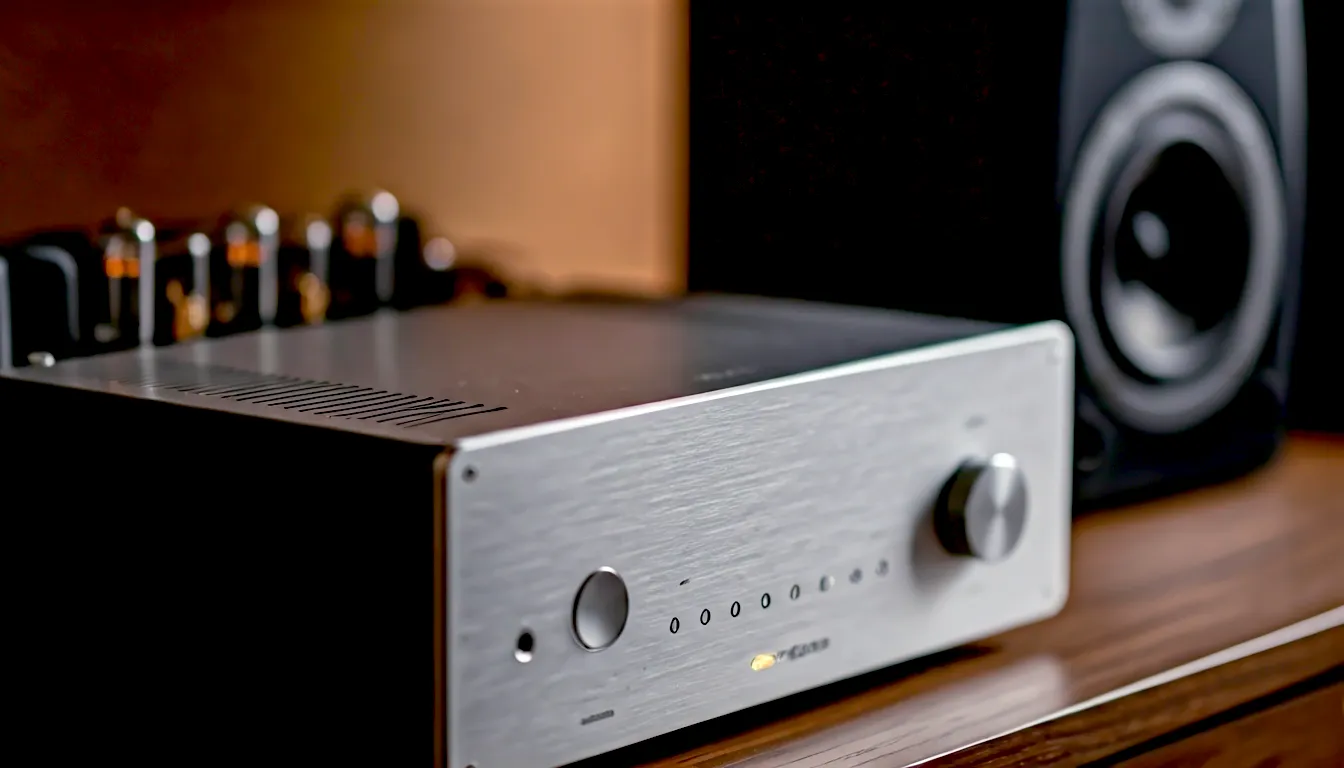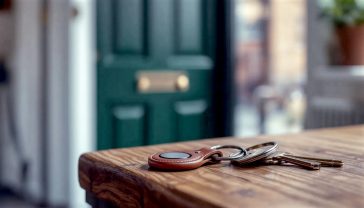How to Connect Speakers to an Amplifier: The Ultimate UK Guide
Your complete guide to wiring your hi-fi or home cinema. We cover speaker wire, banana plugs, polarity, and troubleshooting for a flawless setup.

This post may contain affiliate links. If you make a purchase through these links, we may earn a commission at no additional cost to you.
There’s a special kind of magic in unboxing a new piece of hi-fi kit. The clean lines of the amplifier, the solid heft of the speakers, the promise of incredible sound that’s waiting to fill your room. It’s an exciting moment. But between you and that audio bliss lies a final, crucial step: connecting it all together.
For many, this is where a little uncertainty creeps in. You’re faced with a tangle of terminals, a reel of cable, and a nagging fear of getting it wrong. Will it be complicated? Could you break something?
Let’s put those worries to rest. Connecting speakers to an amplifier is one of the most straightforward and satisfying jobs in home audio. It doesn’t require an engineering degree or a shed full of specialist tools. All it takes is a little patience and a clear understanding of a few basic principles.
This guide is here to walk you through every step of the process, from choosing the right cable to troubleshooting common hiccups. We’ll keep it simple, clear, and free of jargon. Think of it as having a knowledgeable mate from Richer Sounds right there with you, guiding you along. By the end, you’ll not only have your system up and running, but you’ll also understand exactly how it works. So, let’s get stuck in and bring that new system to life.
Part 1: Understanding the Key Players
Before we start plugging things in, let’s quickly get to know the three main components we’re dealing with. Understanding what each part does makes the whole process make a lot more sense.
What’s an Amplifier (or AV Receiver)?
Think of your amplifier as the heart and brain of your sound system. It has two main jobs. First, it’s the control hub where you select what you want to listen to (your turntable, TV, or a Spotify stream). Second, and most importantly for this job, it takes the small, delicate audio signal from your source and amplifies it, making it powerful enough to physically move the components inside your speakers and create sound.
Whether you have a classic stereo amplifier for music or a multi-channel AV Receiver for home cinema, its role in powering your speakers is exactly the same. On the back, you’ll find a set of speaker terminals, usually in pairs marked for each speaker (e.g., ‘Right’ and ‘Left’).
What Are Passive Speakers?
The speakers we’re talking about here are passive speakers. This is the most common type of hi-fi speaker you’ll find, from small bookshelf models to towering floorstanders.
Think of them as the voice of your system. They are ‘passive’ because they don’t have their own power source. They rely entirely on the power sent to them from the amplifier to work their magic. Inside each speaker cabinet are drivers—the cone-shaped things you see—and a clever bit of circuitry called a crossover. When the amplifier’s power arrives, it makes the drivers vibrate, pushing air to create the sound waves you hear. All you need to do is get that power to them.
(A quick note: You might have heard of ‘active’ or ‘powered’ speakers. These have their own amplifiers built-in and plug directly into the mains. They are connected differently, usually with a different type of cable, not speaker wire.)
What is Speaker Wire?
If the amplifier is the heart and the speakers are the voice, then speaker wire is the vital bridge that connects the two. It’s the pathway that carries the amplified electrical signal from your amp to your speakers.
It might look complicated, but it’s incredibly simple. A standard speaker cable is just two separate bundles of copper wires running alongside each other, each inside its own insulated sleeve (usually made of plastic).
- One of these conductors is for the positive (+) part of the signal.
- The other is for the negative (-) part of the signal.
That’s it. The entire job of connecting your system boils down to running this simple two-part cable from the correct positive and negative terminals on your amp to the matching positive and negative terminals on your speaker.
Part 2: Gathering Your Tools and Choosing Your Cable
You don’t need a toolbox worthy of a B&Q advert, but having a couple of key items on hand will make the job much smoother.
The Toolkit: What You’ll Need
- Wire Strippers/Cutters: This is the most important tool. A proper pair of wire strippers will let you remove the outer insulation cleanly without accidentally cutting the delicate copper strands inside. You can use scissors or a craft knife in a pinch, but it’s much easier and safer with the right tool.
- Scissors or a Knife: For cutting the speaker cable to length.
- A Ruler or Tape Measure: To ensure you cut the right lengths of cable for each speaker.
And that’s usually all you need. If you decide to use certain types of connectors, you might need a small screwdriver, but for a basic connection, you’re good to go.
Choosing the Right Speaker Cable
Walking into an audio shop or browsing online, you’ll see a dizzying array of speaker cables, from budget-friendly options to eye-wateringly expensive ones that look like they could moor a battleship. For most people, a good-quality, basic cable is all you’ll ever need. The most important factor isn’t the price, but its thickness.
Decoding Wire Gauge
The thickness of a speaker wire is known as its gauge, often measured in AWG (American Wire Gauge). It’s a bit counter-intuitive: the lower the AWG number, the thicker the cable.
Why does this matter? Think of it like a water pipe. A thicker pipe can carry more water over a long distance with less effort. Similarly, a thicker speaker wire can carry the electrical signal over longer distances with less signal loss.
Here’s a simple rule of thumb for typical home setups:
- For runs under 15 metres (about 50 feet): A 16 AWG cable is perfectly fine for most speakers. This is a great, affordable all-rounder.
- For runs over 15 metres or for very power-hungry speakers: Stepping up to a thicker 14 AWG or 12 AWG cable is a good idea to ensure you’re not losing any performance.
You’ll often see this sold as ‘79 strand’ cable in the UK, which is a good, solid choice for most systems.
Copper Quality: Does it Matter?
You’ll see cables advertised as being made from ‘Oxygen-Free Copper’ (OFC). The idea is that removing impurities from the copper improves its conductivity. While technically true, for most listeners with most systems, the difference in sound between standard copper and OFC is practically impossible to hear. The cable’s gauge is far more important. Don’t feel you need to spend a fortune; a reliable cable from a brand like QED or AudioQuest will do a fantastic job.
Part 3: Identifying Your Connections
Before you can plug anything in, you need to know what you’re plugging into. Your amplifier and speakers will have one of two common types of connectors.
On Your Amp and Speakers
Binding Posts: The Versatile Standard
These are the most common type of connector on modern hi-fi gear. A binding post is a small threaded post surrounded by a plastic cap, which is almost always colour-coded: red for positive (+) and black for negative (-).
They work by unscrewing the cap to reveal a hole through the metal post. You insert your speaker wire (or a connector) into this hole and then tighten the cap back down to clamp it securely in place. Their big advantage is their versatility—they can accept almost any type of connection.
Spring Clips: Quick and Easy
You’ll often find these on more budget-friendly amplifiers or smaller mini-systems. They are simple, spring-loaded terminals. You press a small lever (again, colour-coded red and black) to open a little hole, insert the bare speaker wire, and release the lever. The spring clamps down on the wire, holding it in place.
They are very fast and easy to use, but their main drawback is that they generally only accept bare wire and don’t provide as firm a grip as binding posts.
On Your Speaker Wire: The Four Main Ways to Connect
Once you have your speaker cable, you need to decide how you’ll attach it to those binding posts or spring clips. You have a few options.
1. Bare Wire: The Universal Method
This is the most direct and common way to connect speakers. It involves stripping a small amount of insulation from the end of the wire and connecting the exposed copper strands directly to your amp and speakers. It costs nothing and provides a great electrical connection. It works with both binding posts and spring clips.
2. Banana Plugs: The Convenient Choice
Banana plugs are small, cylindrical connectors that you attach to the ends of your speaker wire. The plug then pushes directly into a hole found in the centre of most binding posts (you might need to remove a tiny plastic safety cap first).
Why use them? Pure convenience. They make plugging and unplugging speakers incredibly quick and easy, and they reduce the risk of stray wire strands causing a short circuit. They are a popular and worthwhile upgrade.
3. Spade Connectors: The Secure Option
Spades are small, U-shaped connectors that you fit to the end of your wire. To connect them, you unscrew the binding post cap, slide the spade around the metal post, and then tighten the cap down firmly on top of it. They offer a very large contact area and an incredibly secure fit, but they take a little longer to connect than banana plugs.
4. Pin Connectors: The Niche Solution
These are less common. They look like a small metal pin and are designed to work well with spring-clip terminals, offering a more solid connection than bare wire in that scenario.
For most people, the choice is between bare wire for simplicity and banana plugs for convenience.
Part 4: The Step-by-Step Connection Guide
Right, we’ve covered the theory. Now it’s time for the practical bit. Grab your tools and let’s get this done.
Step 0: Safety First!
This is the most important step. Before you touch a single cable, power down both your amplifier and any other connected equipment. Don’t just put it on standby—turn it off at the unit itself, and then for complete safety, unplug it from the mains wall socket. This eliminates any risk of electrical shock or damage to your new gear.
Step 1: Measure and Cut Your Cable
Place your speakers and amplifier where you want them to live. Now, run your speaker cable from the amplifier to one of your speakers. Don’t pull it taut; leave a little bit of slack so the cable isn’t under strain and you have room to move the speaker slightly if needed.
Once you’re happy with the length, cut the cable. Now, use this first piece as a template to cut an identical length for the other speaker. Using equal lengths for both speakers is good practice to ensure the electrical properties are the same for both channels.
Step 2: Prepare the Bare Wire
Take one end of a cable. Your speaker cable consists of two joined conductors. First, gently pull them apart. You’ll only need to separate them by about 5cm (2 inches).
Now, using your wire strippers, remove about 1cm (or half an inch) of the plastic insulation from the very end of each conductor. Your goal is to expose the copper wire inside without cutting any of the strands. If you are using scissors, carefully score the insulation all the way around and then pull it off.
Once the copper is exposed, twist the strands together tightly with your fingers. This tidy bundle will be much easier to insert into the terminals and will prevent any stray strands from causing problems. Repeat this process for both ends of both of your speaker cables.
Step 3: (Optional) Attaching Connectors
If you’ve decided to use banana plugs or spades, now is the time to fit them. Most simply attach with a small screw that clamps down onto the bare wire you’ve just prepared. Follow the instructions that came with your chosen connectors.
Step 4: Connecting the Wire to Your Amplifier
Have a look at the back of your amplifier. You will see the speaker terminals, clearly labelled. For a stereo setup, you’ll be focusing on the ‘Front Right’ and ‘Front Left’ outputs.
Each output will have a red (+) and a black (-) terminal.
- Choose a cable. Let’s start with the right speaker.
- Identify the positive and negative conductors on your wire. (We’ll cover exactly how in the next section).
- Connect the positive conductor to the red (+) terminal on the amplifier’s ‘Front Right’ output.
- For binding posts: Unscrew the red cap, insert the wire or banana plug, and tighten it firmly.
- For spring clips: Press the red lever, insert the wire, and release.
- Connect the negative conductor to the black (-) terminal on the amplifier’s ‘Front Right’ output.
- Give both connections a gentle tug to make sure they are secure.
Now, repeat this process for the ‘Front Left’ output with your second speaker cable.
Step 5: Connecting the Wire to Your Speakers
Now, simply repeat the process at the other end.
- Take the cable coming from the amplifier’s ‘Front Right’ output and connect it to your right speaker.
- Connect the positive conductor to the red (+) terminal on the speaker.
- Connect the negative conductor to the black (-) terminal on the speaker.
- Repeat for the left speaker, ensuring the cable from the amp’s ‘Front Left’ output goes to the left speaker.
And that’s the physical connection done. You’ve successfully built the bridge.
Part 5: The Two Most Important Rules
Getting the wires connected is one thing, but getting them connected correctly relies on two golden rules. Getting these right is the difference between glorious sound and disappointing problems.
Rule #1: Polarity is Everything
This is, without a doubt, the single most important thing to get right.
What is Polarity?
It’s just a fancy way of saying you must connect positive to positive and negative to negative. The signal from your amplifier should flow from the red (+) terminal, through the positive conductor of your speaker wire, and into the red (+) terminal on your speaker. The same goes for the black (-) terminals.
This ensures your speakers are working together, or are ‘in-phase’. When a bass drum hits in a recording, the cones of both speakers should push outwards at exactly the same time.
What Happens if it’s Wrong?
If you accidentally wire one speaker correctly (+ to +) but the other one incorrectly (+ to -), your speakers will be ‘out-of-phase’. As one speaker cone pushes out, the other will be pulling in. They will be fighting against each other.
The audible result? The sound will be thin, weak, and strangely hollow. Most noticeably, the bass will almost completely disappear. The low-frequency sound waves from each speaker will cancel each other out in the middle of the room. You’ll also find the stereo image is messy and confusing; sounds won’t seem to come from a specific location between the speakers. It just sounds wrong.
How to Identify Polarity on Your Cable
Speaker cable manufacturers make this easy for you. Since both conductors inside are identical, they add a marking to one of them so you can tell them apart. Common identifiers include:
- A printed stripe or text on the insulation of one conductor.
- A small ridge or groove in the plastic of one conductor.
- One conductor having a different coloured insulation (e.g., copper-coloured for positive, silver-coloured for negative).
Before you start, decide which marking you will use for positive. For example, “The conductor with the white stripe is my positive.” As long as you are consistent and stick to your rule for every single connection, you can’t go wrong.
Rule #2: Match Your Impedance (Ohms)
This sounds a bit technical, but the concept is very simple and important for the health of your amplifier.
What are Ohms?
Impedance, measured in Ohms (symbol: Ω), is basically a measure of electrical resistance. It tells you how difficult it is for the amplifier to ‘push’ the electrical signal through the speaker.
Think of it like this:
- A speaker with a low impedance (e.g., 4 Ohms) is like a very wide pipe. It’s easy for the amplifier to push lots of power through it.
- A speaker with a high impedance (e.g., 8 Ohms) is like a narrower pipe. It puts up more resistance.
Why Does it Matter?
Your amplifier is designed to work with speakers within a certain impedance range. Pushing power into a speaker with an impedance that is too low can be like trying to empty a fire hose through your amp—it draws too much electrical current, which can cause the amplifier to overheat and potentially shut down or even suffer permanent damage.
Luckily, this is very easy to check.
- Look on the back of your speakers. You will see the impedance printed near the terminals. It’s usually ‘8 Ohms’ or ‘6 Ohms’. Some are ‘4 Ohms’.
- Look on the back of your amplifier. It will also state the impedance range it’s designed for, for example, ‘4-8 Ohms’ or ‘6-16 Ohms’.
As long as your speakers’ impedance falls within the range your amplifier can handle, you’re absolutely fine. Most modern equipment is designed to work together without issue, but it’s always worth a quick 30-second check.
Part 6: Wiring Different Setups
The principles of polarity and secure connections are the same no matter what kind of system you have.
The Classic Stereo System (2.0 or 2.1)
This is the most straightforward. You simply connect your amplifier’s ‘Front Right’ and ‘Front Left’ outputs to your two speakers, as described in our step-by-step guide.
If you have a ‘.1’ system, you also have a subwoofer. Most subwoofers are active (they have their own built-in amp) and connect to a dedicated ‘Sub Out’ or ‘LFE’ socket on your amplifier with a different type of cable (an RCA cable), not speaker wire.
A Basic Home Cinema System (5.1)
For surround sound, you just have more speakers to connect, but the process is identical. Your AV Receiver will have terminals for:
- Front Right & Left: Your main stereo pair.
- Centre: The speaker for dialogue, which sits under your TV.
- Surround Right & Left: The speakers that sit to the side or behind you.
You simply run a speaker cable to each one, making sure that the terminal marked ‘Centre’ on the receiver goes to your centre speaker, and so on. It’s just a case of repeating the process while keeping your connections organised.
Part 7: For the Enthusiast: Bi-Wiring and Bi-Amping
You might see some speakers with four terminals on the back instead of two. These speakers can be bi-wired or bi-amped. This is an advanced topic, but here’s a quick overview.
What is Bi-Wiring?
Some speakers have separate inputs for high frequencies (treble) and low frequencies (bass). Normally, these are joined together by a little metal plate.
Bi-wiring involves removing these plates and running two separate sets of speaker cable from the same amplifier terminals to the speaker. One cable connects to the treble terminals, and the other connects to the bass terminals. The theory is that this provides a cleaner path for each frequency range. The benefits are hotly debated among audio fans, but it’s an option for tweakers to experiment with.
What is Bi-Amping?
This takes the concept a step further and uses two separate amplifiers to power one pair of speakers. One amp handles the treble for both speakers, and the other handles the bass. This is a complex setup for serious enthusiasts looking for the ultimate performance and is not something beginners need to worry about.
Part 8: Troubleshooting: “Why Isn’t It Working?”
You’ve connected everything, you plug it all back in, press play… and something’s not right. Don’t panic! The cause is almost always something very simple.
Common Problem #1: No Sound at All
- Check the Obvious: Is the amplifier turned on? Is the volume turned up? Have you selected the correct input source (e.g., ‘CD’, ‘Streamer’)?
- Check the Connections: Are all the wires firmly clamped at both the amp and speaker ends? A loose connection is a common culprit.
Common Problem #2: Sound from Only One Speaker
This tells you the amplifier is working, but the signal isn’t reaching the silent speaker.
- Check the Wiring: Carefully check the connections for the silent channel at both ends.
- Swap the Channels: A great diagnostic trick. Swap the speaker cables over on the back of the amplifier (put the left cable into the right terminal and vice-versa). If the other speaker now goes silent, it suggests a problem with that channel of your amplifier. If the same speaker remains silent, the problem is likely with the cable or the speaker itself.
Common Problem #3: Weak Bass and a ‘Hollow’ Sound
- It’s Polarity: This is the classic symptom of one speaker being wired out-of-phase. Power everything down and carefully double-check that your positive and negative connections are correct for both speakers.
Common Problem #4: The Amplifier Keeps Shutting Itself Off
This is a sign that the amplifier’s protection circuit is kicking in to prevent damage.
- Check for Stray Wires: The most common cause is a single, tiny strand of copper from the positive terminal touching the negative terminal (or vice versa). This creates a short circuit. Power down and inspect every connection meticulously. Make sure your bare wire ends are tidy and no strands have escaped.
- Check Impedance: Re-check that your speakers’ impedance is compatible with your amplifier.
- Check for Overheating: Is the amplifier in a cramped cabinet with no ventilation? Amps get hot and need space to breathe.
Conclusion: You’re All Set!
See? That wasn’t so hard. By following these steps and understanding the core principles of a secure connection and correct polarity, you have successfully set up your own hi-fi system. You’ve bridged the gap between your components and paved the way for countless hours of musical enjoyment.
It’s a genuinely satisfying feeling to know you did it yourself. Now, the best part. Put on your favourite album, sit back in your comfiest chair, and turn it up. You’ve earned it.
Further Reading
For more tips, reviews, and discussions, these are some of the most respected resources for UK audio enthusiasts:
- What Hi-Fi?: The UK’s leading home entertainment publication, with expert reviews and advice.
- Richer Sounds – Tech Blog: A fantastic resource with clear, helpful articles from one of the UK’s favourite hi-fi retailers.
- AVForums: A massive and knowledgeable community of UK audio and video fans, perfect for asking questions and sharing experiences.






